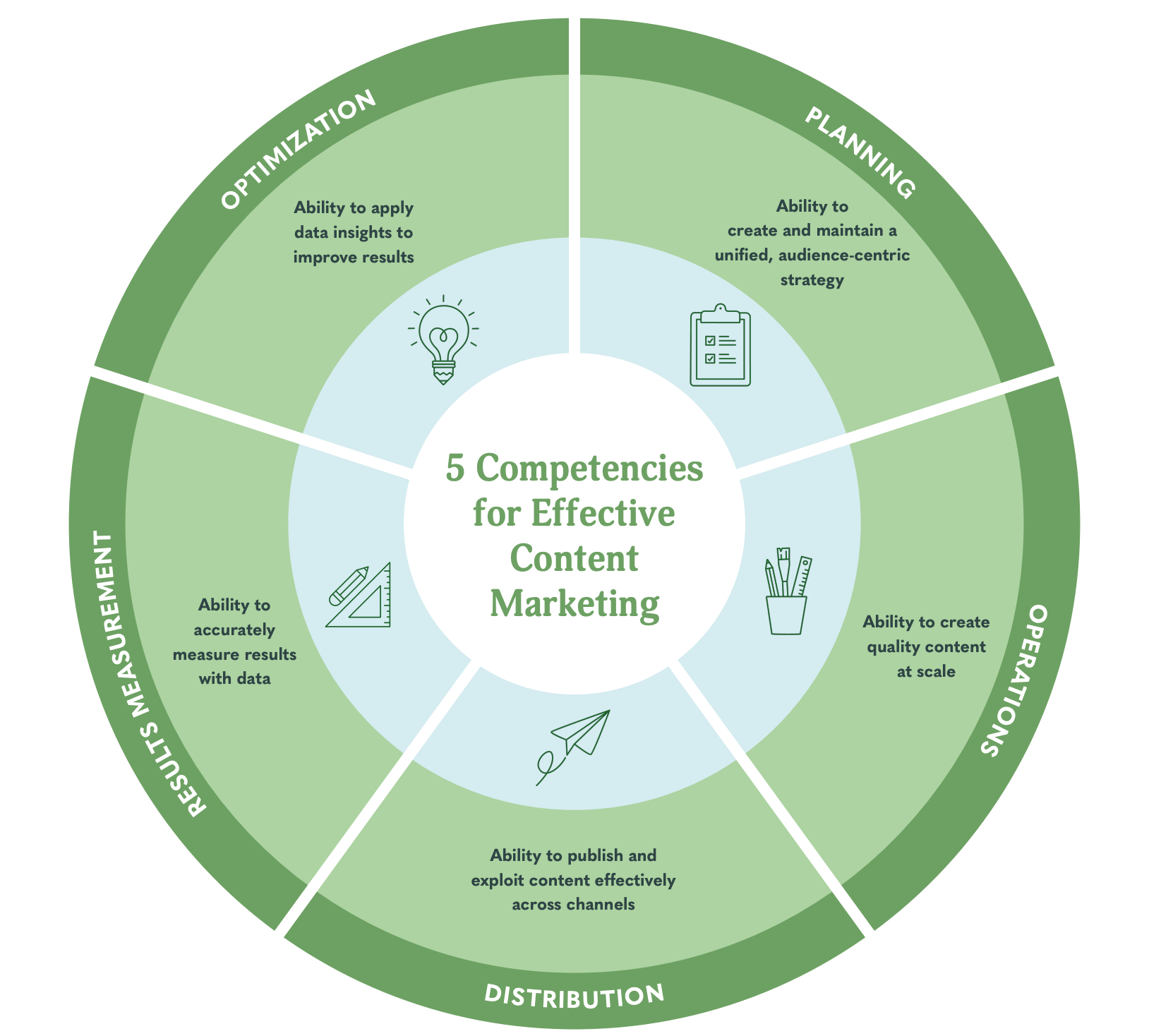Content Creation
5 Content Marketing Competencies Behind All-Star Campaigns and How to Implement Them into Yours
By Carrie Dagenhard on July 15, 2020
Like many others, I've spent much of my quarantine stress-baking. Currently, I have a three-month-old sourdough starter whose name is Walter. And if there's one lesson I've gleaned from my painstaking new hobby, it's that recipes include precise measurements and instructions for a reason. When you skip a step or omit an ingredient, you run the risk of jeopardizing your final product's quality. The same holds true for content marketing.
As with most marketing efforts, content success is rooted in a specific science. When you follow the correct order of operations and include all the necessary components, your content can captivate audiences and drive lasting, lucrative connections. But when you take shortcuts or leave out essential elements, you'll inevitably weaken your results or, in some cases, totally fail.
The 5 Key Ingredients of Successful Content Marketing
There's a reason why some content programs yield massive ROI while others struggle, and it all boils down to the five elements depicted in the diagram below: planning, operations, distribution, results measurement, and optimization.

Image attribution: Skyword.
To help set your brand up for content success in 2020 and beyond, we're exploring each of these competencies as well as providing tips on how to prioritize them in your marketing strategy.
Planning
Any marketing effort that's launched without a plan is most certainly doomed to fail. Planning, which refers to the ability to develop and maintain a unified and audience-centric strategy, is the most important of these five competencies. Why? Because without a cohesive plan, the other four competencies don't even come into play.
Your planning phase should include:
-
Documented personas: Outline who your audience is, their needs and preferences, and the challenges they face. Personas should also consider what your audience is hoping to accomplish and how much decision-making power they wield.
-
Audience journey maps: Define each stage of the buyer journey for all of your audience personas.
-
Competitive landscape analysis: Review and analyze your competitors' search, social, and editorial efforts.
-
A mix of content: Identify what types of content your audience will be most eager to consume at each stage of their journey.
-
A unified marketing calendar: Document each of the content assets you plan to create and schedule them according to your goals and preferred cadence.
-
Documented KPIs: Determine the leading and lagging key performance indicators you'll use to measure success, such as leads, traffic, and cost of acquisition.
Operations
Operations refers to how you'll create content at scale, which includes the people and processes that make asset creation and publishing possible. This competency is critical to your success, yet a majority of marketers fail to have a documented content strategy, according to 2017 data from the Content Marketing Institute and MarketingProfs. That's a problem, because without a clear playbook to follow, it's nearly impossible to deliver and replicate consistent content success.
Your operations should include:
-
Documented roles, governance, and workflows: Identify who is responsible for what, how you'll manage content creation, and the steps your team should follow.
-
Scalable creative talent: Determine how you'll deliver a significant volume of high-quality content as your audience grows. Having access to a pool of reliable freelancers is extremely valuable when you need to outsource content creation.
-
Centralized production management: Instead of ad hoc content creation, it's essential that you centralize the process to ensure all efforts align with your top objectives.
-
Clear content creation guidelines: Provide guidance around your brand's voice, tone, and style to ensure consistency across all your content assets.
-
Editorial QA and SEO enforcement: Identify who is responsible for quality assurance and adherence to SEO principles, and how they'll manage these efforts.
-
Consistent publishing: To keep your audience returning and to nurture them through the buyer journey, you must maintain a regular publishing cadence.
Distribution
It's a common misconception that once you've published your content, you can just sit back and wait for traffic to roll in. If this were true, our jobs would be much, much easier. In reality, search engine optimized content will generate some organic traffic, but most of your visits will likely come from distribution efforts. In other words, content success heavily depends on how effectively you deploy your marketing assets across different channels.
Your distribution strategy should include:
-
A documented channel strategy: Establish where you'll publish and share your content as well as a cadence and expectations for these efforts.
-
A content hub: Create a domain that houses all of your content resources so visitors can easily find the information they need.
-
Amplification: Lay out the methods you'll use to boost your content's reach, including your social media strategy, PR campaigns, and employee advocacy efforts.
-
Lead nurturing: Identify how you'll get the right content in front of the right prospects at the right stage in their journey, whether that's through personalized email campaigns or targeted CTAs.
-
Paid optimization: In addition to your organic SEO efforts, determine what sorts of paid marketing you'll leverage to expand your content's reach, such as sponsored social posts and keyword-bidding via Google Ads.
-
Sales enablement: Formulate plans for arming your sales team with the compelling content they'll need to close deals and deepen existing customer relationships.
Results Measurement
Once you've published and distributed your content, the next step is to make sure it's doing what it should be doing. You need to be able to monitor its performance and quantify those results using data. That means parsing insights and determining whether your content is achieving its intended goals.
Your results measurement efforts should include:
-
Documented benchmarks and quantitative goals: Use existing content performance to set benchmarks, then identify where you want to go next. For example, if you earn an average of 500 visits a blog post, you might aim to grow this number by 250 visits each quarter.
-
Access to data and analytics dashboards: Determine where you'll gather your insights and how you'll visualize your data for easy at-a-glance analyses.
-
Configuration of goal-tracking and funnel attribution: Establish how you'll tie back leads to specific content efforts and cultivate more data-driven decision-making.
-
Omnichannel reporting: Lay out how you'll assess performance on channels you don't own, such as social media and paid marketing.
-
Performance measurement: Set expectations for how often you'll review your data. Hint: This is something you'll want to do on the regular.
-
ROI calculation: Create a process for regularly communicating your content's value to key stakeholders. Ensure you can speak to the returns your strategies are generating for your brand.
Optimization
Whenever I bake, I always think of ways to tweak the recipe in the future, even if the end result is delicious. Maybe I'll add a few chocolate chips to jazz up my banana bread, or I'll substitute applesauce for oil to make healthier muffins. The point is, you should never stop trying to improve your product. Optimization means using the insights you've gleaned to replicate your successes and drive even better results in the future.
Your optimization process should include:
-
Performance measurement: Regularly check your data to determine what you need to optimize.
-
Analysis of competitive threats and opportunities: Keep an eye on what your competitors are doing to gain campaign inspiration and ensure you're keeping pace with them. Additionally, keep abreast of new methods to boost your content's performance.
-
Analysis of audience trends: Monitor content consumption behaviors, then shift your asset formats and distribution efforts accordingly to match your audience's evolving preferences.
-
Insights applied to strategy, ideation, and distribution: Use data to discover fresh ideas for new content, calibrate your distribution, and further elevate your content strategy.
-
Insight sharing across departments: Share performance data across the organization to help foster cross-departmental buy-in for your content efforts.
-
Content audits: Perform regular audits to pinpoint gaps in your content strategy, identify older high-performing pieces that you can refresh, and ultimately amplify your marketing success going forward.
Tying It All Together
Content marketing has the power to grow your audience, generate new business, and transform existing customers into loyal brand advocates. It's also a complex, multi-faceted endeavor. If you're not purposeful in your approach, it can be difficult to realize the true ROI of your efforts.
In the same way that baking random contents from my pantry probably won't produce an amazing cake, creating and publishing all sorts of ad hoc content assets without following a proven recipe rarely drives success. However, by focusing on developing these five competencies, you'll be well-positioned to yield consistently impressive results.
For more stories like this, subscribe to the Content Standard newsletter.
Featured image attribution: Retha Ferguson on Pexels.
